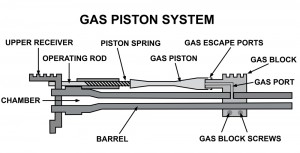Modern Gun School Special Content
By Richard Mann

Some say the gas impingement operating system is like a person who poops on the same table they eat from. But is that really fair? Here are Richard Mann's 6 factual observations in the AR-15 gas impingement vs. piston debate.

As someone who tests and reviews guns for a variety of firearms periodicals, I’ve had the opportunity to test versions of both the gas impingement and piston-driven ARs. Here are my factual discoveries:
1. Piston-driven guns run much cleaner. Fire a 30-round magazine through a piston-driven AR and it will look just as clean afterwards as it did before you fired it.
2. Piston-driven guns run much cooler. You’ll have to shoot about 100 rounds through a piston gun and a gas gun to really feel the difference, but it is there.
3. On average, piston-driven guns are less accurate. This does not mean piston-driven ARs are inaccurate, but, looking over my test records, the most accurate ARs I’ve tested have been those that work with the gas impingement system.
4. On average, piston-driven guns cost more. This observation must be qualified with “it depends.” There are some very expensive gas impingement ARs and some piston-driven ARs that are not all that expensive. However, if you want to purchase the least expensive AR possible, it will be a gas impingement gun.

5. If you intend to run a suppressor on your AR, it has been my experience that the gas impingement guns are more suppressor-friendly, especially those with an adjustable gas block that allows you to control the amount of gas directed back through the gas tube.
6. Both piston-driven and gas impingement guns are very reliable. If, by magic, you inserted me in the pages of Bryce Towsley’s book The 14th Reinstated and I had to live through a social and economic collapse where there were roving bands of marauders, and if you told me I had to pick between a gas impingement or a piston-driven AR, I really would not care which one I ended up with. Except for three things: parts for gas impingement ARs are easier to find, much more plentiful, and less expensive.
Now, here’s the good news. The unmatched modularity of the AR allows you to, in a way, have your cake and eat it, too. If you own a gas impingement AR and want to try a piston-driven AR, just purchase a piston-driven upper receiver. Since the gas impingement and piston systems work independently of the lower receiver, you can alternate between both on the same lower receiver.
Editor's note, this article appeared in Gun Digest Shooter's Guide to the AR-15.
 Have the most trusted gun values resource at the tips of your fingers with our NEW Find Guns app. The app is powered by the Standard Catalog of Firearms and is available for Android and Apple devices, as well as on standard web browsers. The app also makes finding gun shows a snap with updated listings of events around the county. Get yours now by CLICKING HERE!
Have the most trusted gun values resource at the tips of your fingers with our NEW Find Guns app. The app is powered by the Standard Catalog of Firearms and is available for Android and Apple devices, as well as on standard web browsers. The app also makes finding gun shows a snap with updated listings of events around the county. Get yours now by CLICKING HERE!

